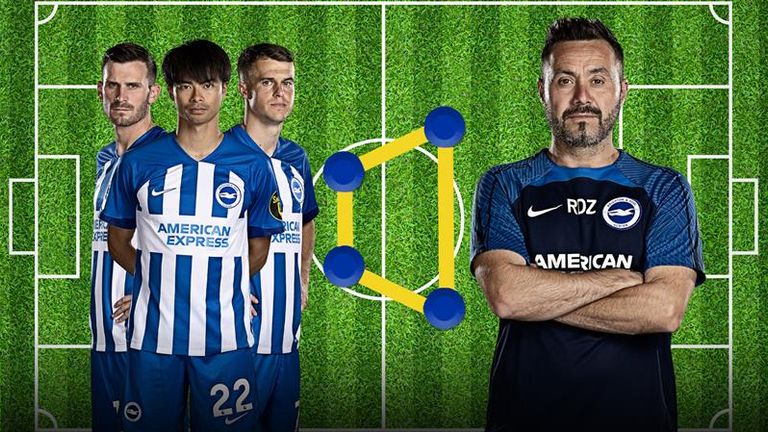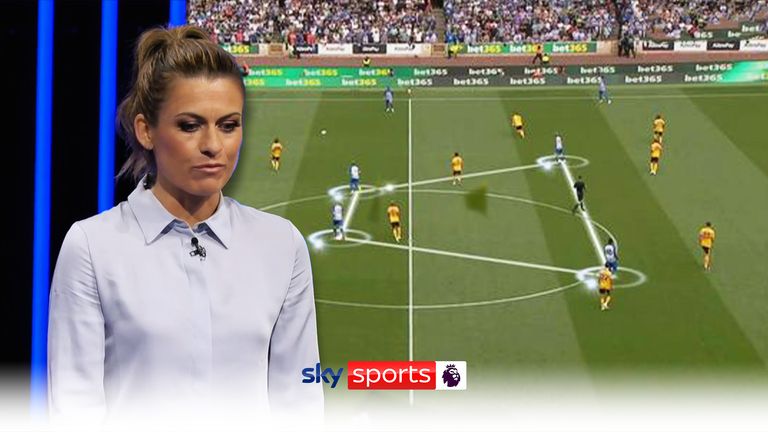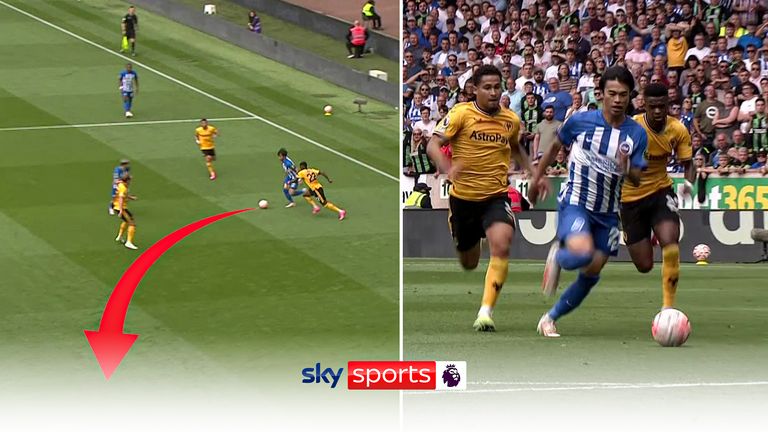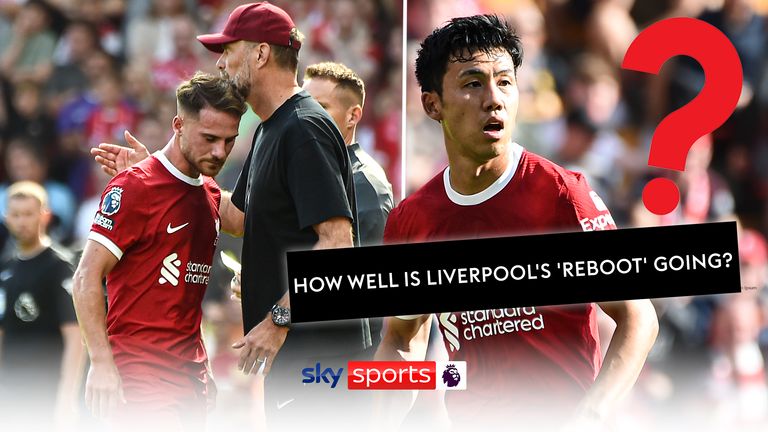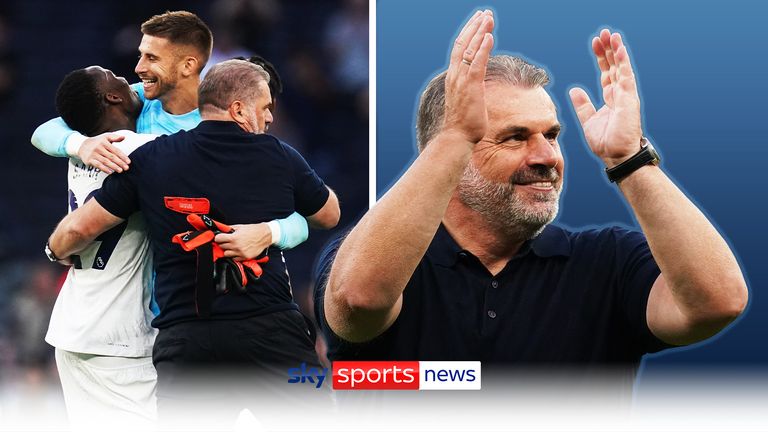Tactical analysis: How Man City, Brighton, Aston Villa are using the 'box midfield' to slice open opposition
Manchester City, Brighton and Aston Villa are perfecting the use of the 'box midfield', a playing style that has reignited the game and is here to stay; we look at the tactic - and its potential pitfalls
Wednesday 23 August 2023 17:27, UK
"When you talk about great passes of a ball, I think these are the best passes a midfielder can make. What they do is they take out the front four. You can see players spreading the play, 60-yard passes across the pitch - but this takes players out of the game."
Jamie Carragher had to stop Gary Neville in his tracks as he observed on the brand-new giant screen in the Monday Night Football studio a passing channel in Manchester City's build-up to their winning goal last weekend against Newcastle.
The 10-yard pass. Players receiving the ball in pockets. Players on the half-turn. Defenders pointing, passing on to team-mates unaware of their opponent on their left, or right, shoulder.
It is partly why the market has seen those who are highly skilled at playing these roles, with peripheral vision, fetching northwards of £100m. There is a fair amount of clout that comes with the game's most courageous ball players.
- Arteta: Rice dominated Palace | Carragher: He was outstanding
- Science behind Mitoma's goal | Chelsea bet it all on potential
- What's wrong with Man Utd's midfield?
For Pep Guardiola, possession holds the key. With his inverted full-backs, the Catalan can be viewed as the pioneer of the box midfield, using the likes of John Stones, Manuel Akanji and Rico Lewis to come inside and create a numerical advantage in a central zone.
Guardiola first deployed this tactic at City by using Aleksandar Kolarov and Bacary Sagna centrally in front of his centre-backs more as a strategy to block, cover and screen the central spaces ahead of the defence.
Mikel Arteta has taken this on at Arsenal this season by using Thomas Partey nominally in a right-back role out of possession in order to cater for an additional forward in Kai Havertz, and so far it has been relatively successful in controlling possession in victories over Nottingham Forest and Crystal Palace.
But it is not only the very best teams in the league who are adopting a different strategy to find space in between the lines using a box midfield - and there are variations on precisely who fills the four positions.
During the opening two weekends of the season, Brighton boss Roberto De Zerbi and Aston Villa's Unai Emery have both enjoyed success in using this tactical trend.
Aston Villa 4-0 Everton
Sean Dyche fielded a five-man midfield at Villa Park, but his Everton team couldn't cope with Emery's guile. From the very first whistle, the pattern was set.
Moussa Diaby and John McGinn were tasked as No 10s with coming inside to form a box, with Boubacar Kamara and Douglas Luiz at the base.
Villa might have scored inside 20 seconds through this structure as the ball was worked eventually wide for Lucas Digne as the man over to have his shot blocked.
Everton never learned their lesson and eventually conceded the first of four goals through Diaby being found in behind a statuesque midfield.
Ashley Young was then isolated by Leon Bailey and McGinn peeled off James Garner, ghosted in behind Michael Keane and met the cut-back to score.
Wolves 1-4 Brighton
Brighton were similarly set up in scoring four goals of their own at Wolves, albeit the formation of their box midfield was far more fluid.
Danny Welbeck and Julio Enciso both dropped deep to provide options between the lines for the two No 6s, Pascal Gross and Billy Gilmour.
This allowed for Solly March to operate in a free role while Kaoru Mitoma kept wide.
Wolves, like Everton, had no response and their defence was frequently exposed, caused by the space created either between the centre-backs for Mitoma to run into for his goal, or the space in behind for March to be found for two carbon copy strikes after half-time.
How boxing the midfield can fail
Managers arriving with their own philosophies will inevitably bring with it some teething issues.
Tottenham have accumulated four points from their opening two games and a new-found wave of optimism is drifting through the corridors at Spurs following Ange Postecoglou's arrival.
But in both the Australian's matches, Tottenham's opponents had a higher expected-goals total. Fortuitous deflections were involved in both strikes at the weekend against Manchester United, who missed presentable opportunities to punish their rivals.
As Neville pointed out on Monday, there will be 'high risk, high reward' when it comes to Angeball.
One aspect of it witnessed in the win over United was the use of full-backs Pedro Porro and Destiny Udogie in central positions.
As has been pointed out, part of Spurs' success was a result of the United midfield - Casemiro, Mason Mount and Bruno Fernandes - lacking the dynamism, intensity and - let's face it - familiarity to function as a three.
On another day, against a different opposition with a better high press, Tottenham's attempts of playing full-backs at the base of their box could have led to a different outcome.
When Spurs did have joy playing out, it was more through using Yves Bissouma - an experienced defensive midfielder capable of receiving the ball in tight spaces - to split the two centre-backs and draw opponents in to work around United's press.
You need to have the quality in order to play through these areas. During Liverpool's eventual 3-1 win over Bournemouth, Trent Alexander-Arnold was sacked - in American Football parlance - by Philip Billing in the lead up to Antoine Semenyo's third-minute opener.
As seen throughout their pre-season and further back, were it not for Liverpool's front three and knack of scoring, such an error would have had far greater ramifications.
But plans won't be easily aborted after one glitch in the system. The arrival of Japan midfielder Wataru Endo will enable Jurgen Klopp to trial Alexander-Arnold more as an inverted full-back in a 3-2-2-3 that has Dominik Szoboszlai and Alexis Mac Allister as his two No 8s.
You could say that Trent now has his 'Fabinho' back, so when Endo is up to speed, we can expect to see the system - and results - Klopp fashioned so successfully towards the latter part of last season returning.
After all, Szoboszlai is accustomed to playing in a box midfield having done so cutting inside off the right flank for RB Leipzig under Marco Rose. Trial and error is all part of the reboot.
"We're pushing the precipice in terms of what we should be demanding from full-backs," Neville said. "As a full-back, if I was being passed the ball inside while in my defensive third, I would feel like I would get ambushed."
Specifically on Spurs, Neville noted: "I do feel there are flaws with the way in which they set up. In the early part of the game, while Tottenham might have been 1-0 up, they could easily have also been 1-0 down as United got wise to how Postecoglou was using Porro and Udogie and they pressed them. It very nearly led to two goals.
"The reward is that when you get out of the press, you can get the ball into wide areas and have one-v-ones. I feel some of these coaches have taken a Pep Guardiola idea and evolved it into something that is actually ineffective. There's got to be an adaptation of what we're asking of full-backs.
"I genuinely believe we're in a situation now whereby an idea that's got good principles around it is being taken to a level that doesn't work.
"If you give a ball to a full-back in the defensive third with players around them, they'll lose it far more often than not."
At this early stage of the season, managers are still coming to terms with which of their players can take on these responsibilities.
In the cases of Manchester City, Brighton and Aston Villa, they already look well coached and appear currently to be the Premier League's best practitioners of the art form. The box midfield is a playing style that has reignited the game and is here to stay.

